Leadership and Change Management: ASDA Case Study Report
VerifiedAdded on 2021/02/21
|13
|3908
|56
Report
AI Summary
This report provides a detailed analysis of change management within ASDA, a British supermarket chain. It begins by exploring the impact of organizational change on ASDA's strategy and operations, highlighting the influence of both internal and external drivers, such as political, economic, social, and technological factors. The report then examines how these drivers affect leadership, team, and individual behaviors. It also discusses strategies to minimize the negative impacts of change, including the application of the Burke-Litwin model. Furthermore, the report delves into the barriers to change and their influence on leadership decision-making, followed by an exploration of various leadership approaches to dealing with change in an organizational context. The report concludes with a summary of key findings and a discussion of the practical implications for effective change management within ASDA and similar organizations.
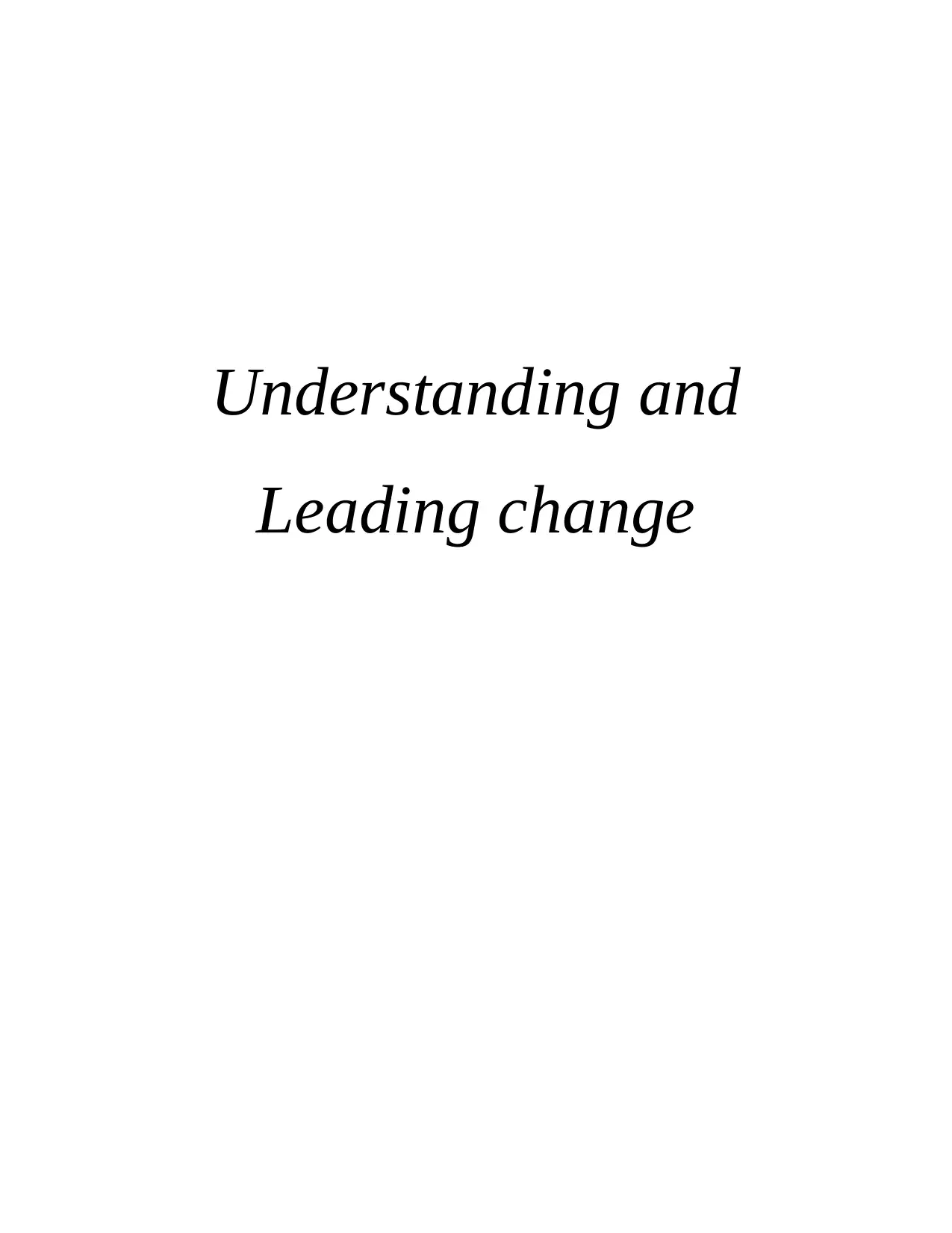
Understanding and
Leading change
Leading change
Paraphrase This Document
Need a fresh take? Get an instant paraphrase of this document with our AI Paraphraser
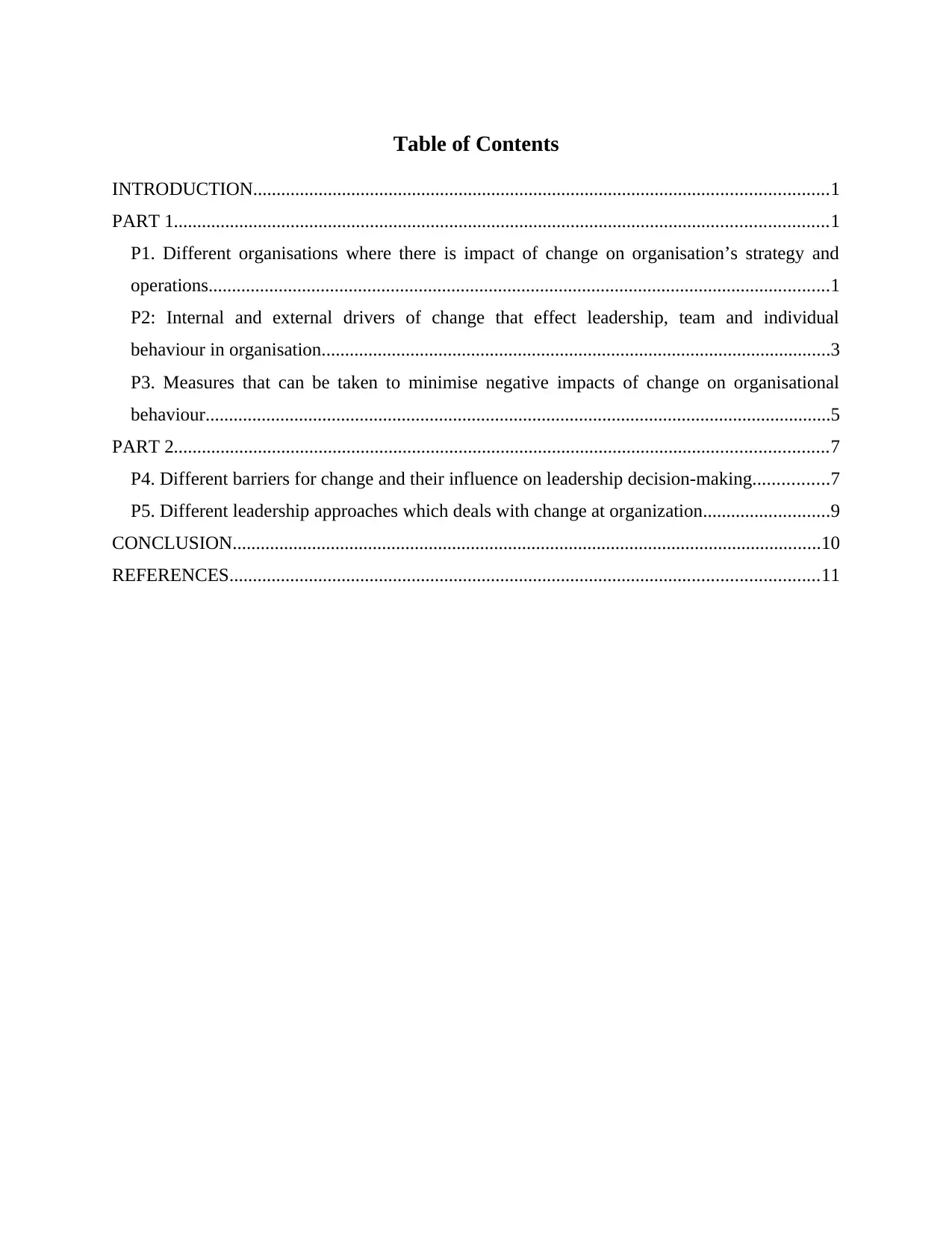
Table of Contents
INTRODUCTION...........................................................................................................................1
PART 1............................................................................................................................................1
P1. Different organisations where there is impact of change on organisation’s strategy and
operations.....................................................................................................................................1
P2: Internal and external drivers of change that effect leadership, team and individual
behaviour in organisation.............................................................................................................3
P3. Measures that can be taken to minimise negative impacts of change on organisational
behaviour......................................................................................................................................5
PART 2............................................................................................................................................7
P4. Different barriers for change and their influence on leadership decision-making................7
P5. Different leadership approaches which deals with change at organization...........................9
CONCLUSION..............................................................................................................................10
REFERENCES..............................................................................................................................11
INTRODUCTION...........................................................................................................................1
PART 1............................................................................................................................................1
P1. Different organisations where there is impact of change on organisation’s strategy and
operations.....................................................................................................................................1
P2: Internal and external drivers of change that effect leadership, team and individual
behaviour in organisation.............................................................................................................3
P3. Measures that can be taken to minimise negative impacts of change on organisational
behaviour......................................................................................................................................5
PART 2............................................................................................................................................7
P4. Different barriers for change and their influence on leadership decision-making................7
P5. Different leadership approaches which deals with change at organization...........................9
CONCLUSION..............................................................................................................................10
REFERENCES..............................................................................................................................11
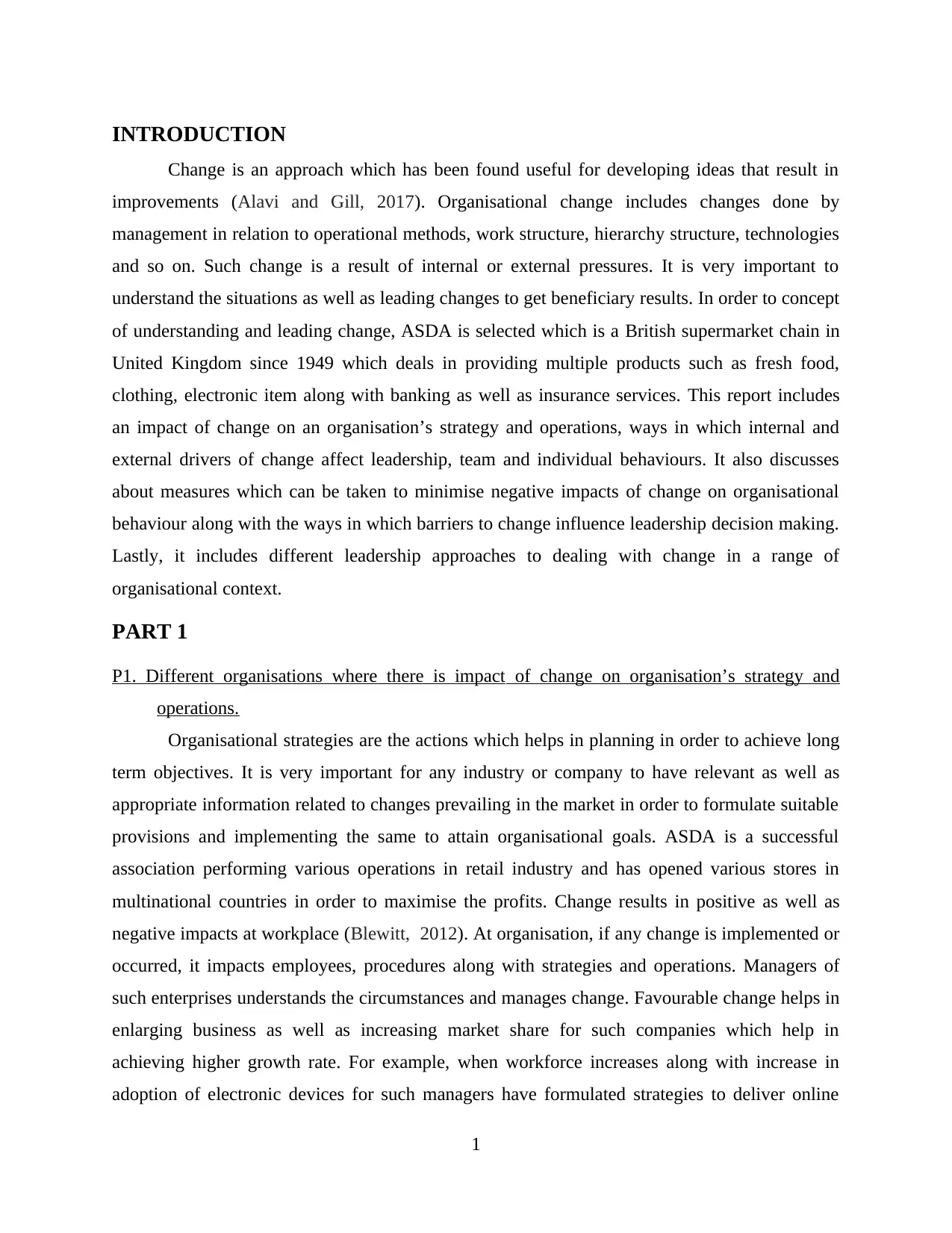
INTRODUCTION
Change is an approach which has been found useful for developing ideas that result in
improvements (Alavi and Gill, 2017). Organisational change includes changes done by
management in relation to operational methods, work structure, hierarchy structure, technologies
and so on. Such change is a result of internal or external pressures. It is very important to
understand the situations as well as leading changes to get beneficiary results. In order to concept
of understanding and leading change, ASDA is selected which is a British supermarket chain in
United Kingdom since 1949 which deals in providing multiple products such as fresh food,
clothing, electronic item along with banking as well as insurance services. This report includes
an impact of change on an organisation’s strategy and operations, ways in which internal and
external drivers of change affect leadership, team and individual behaviours. It also discusses
about measures which can be taken to minimise negative impacts of change on organisational
behaviour along with the ways in which barriers to change influence leadership decision making.
Lastly, it includes different leadership approaches to dealing with change in a range of
organisational context.
PART 1
P1. Different organisations where there is impact of change on organisation’s strategy and
operations.
Organisational strategies are the actions which helps in planning in order to achieve long
term objectives. It is very important for any industry or company to have relevant as well as
appropriate information related to changes prevailing in the market in order to formulate suitable
provisions and implementing the same to attain organisational goals. ASDA is a successful
association performing various operations in retail industry and has opened various stores in
multinational countries in order to maximise the profits. Change results in positive as well as
negative impacts at workplace (Blewitt, 2012). At organisation, if any change is implemented or
occurred, it impacts employees, procedures along with strategies and operations. Managers of
such enterprises understands the circumstances and manages change. Favourable change helps in
enlarging business as well as increasing market share for such companies which help in
achieving higher growth rate. For example, when workforce increases along with increase in
adoption of electronic devices for such managers have formulated strategies to deliver online
1
Change is an approach which has been found useful for developing ideas that result in
improvements (Alavi and Gill, 2017). Organisational change includes changes done by
management in relation to operational methods, work structure, hierarchy structure, technologies
and so on. Such change is a result of internal or external pressures. It is very important to
understand the situations as well as leading changes to get beneficiary results. In order to concept
of understanding and leading change, ASDA is selected which is a British supermarket chain in
United Kingdom since 1949 which deals in providing multiple products such as fresh food,
clothing, electronic item along with banking as well as insurance services. This report includes
an impact of change on an organisation’s strategy and operations, ways in which internal and
external drivers of change affect leadership, team and individual behaviours. It also discusses
about measures which can be taken to minimise negative impacts of change on organisational
behaviour along with the ways in which barriers to change influence leadership decision making.
Lastly, it includes different leadership approaches to dealing with change in a range of
organisational context.
PART 1
P1. Different organisations where there is impact of change on organisation’s strategy and
operations.
Organisational strategies are the actions which helps in planning in order to achieve long
term objectives. It is very important for any industry or company to have relevant as well as
appropriate information related to changes prevailing in the market in order to formulate suitable
provisions and implementing the same to attain organisational goals. ASDA is a successful
association performing various operations in retail industry and has opened various stores in
multinational countries in order to maximise the profits. Change results in positive as well as
negative impacts at workplace (Blewitt, 2012). At organisation, if any change is implemented or
occurred, it impacts employees, procedures along with strategies and operations. Managers of
such enterprises understands the circumstances and manages change. Favourable change helps in
enlarging business as well as increasing market share for such companies which help in
achieving higher growth rate. For example, when workforce increases along with increase in
adoption of electronic devices for such managers have formulated strategies to deliver online
1
⊘ This is a preview!⊘
Do you want full access?
Subscribe today to unlock all pages.

Trusted by 1+ million students worldwide
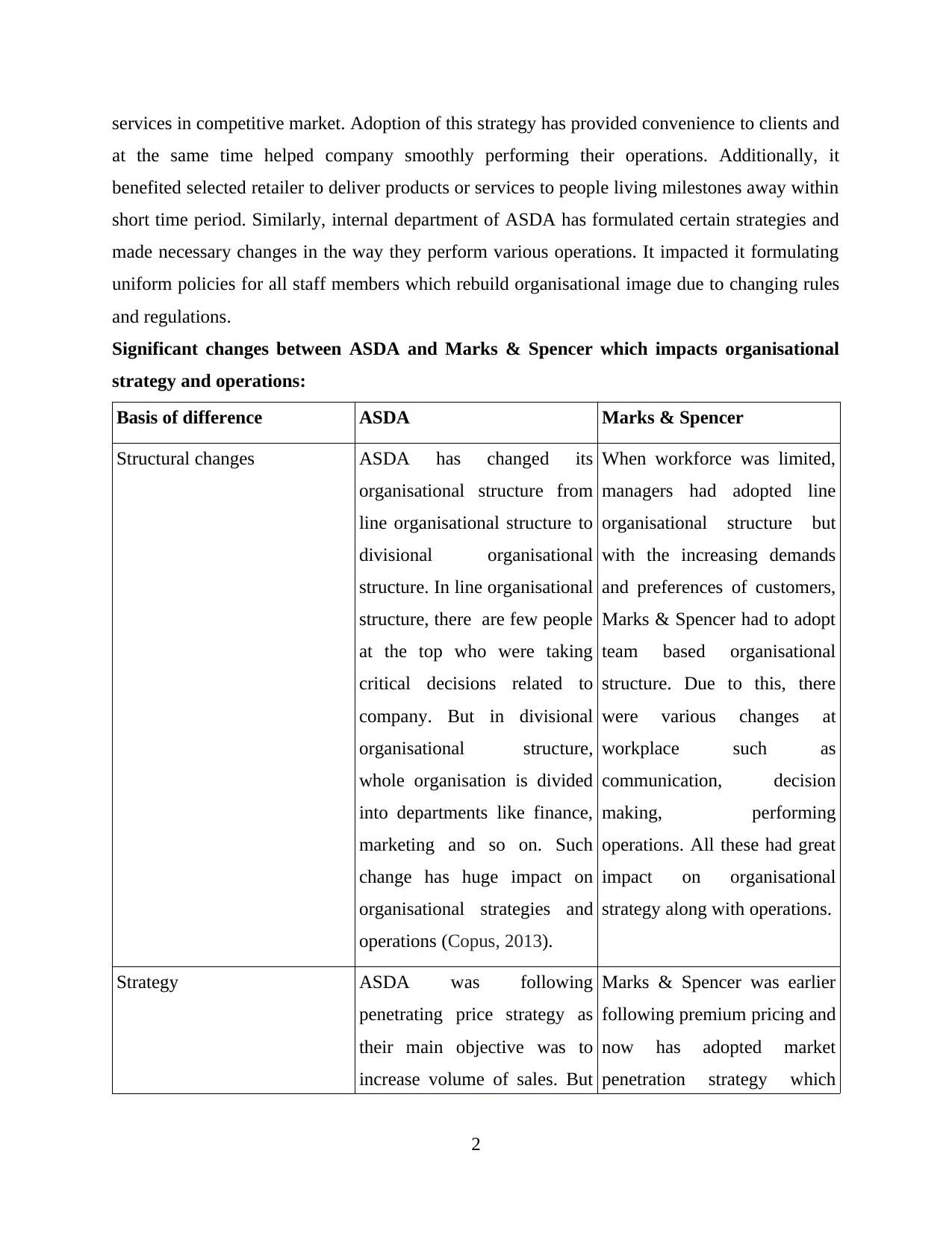
services in competitive market. Adoption of this strategy has provided convenience to clients and
at the same time helped company smoothly performing their operations. Additionally, it
benefited selected retailer to deliver products or services to people living milestones away within
short time period. Similarly, internal department of ASDA has formulated certain strategies and
made necessary changes in the way they perform various operations. It impacted it formulating
uniform policies for all staff members which rebuild organisational image due to changing rules
and regulations.
Significant changes between ASDA and Marks & Spencer which impacts organisational
strategy and operations:
Basis of difference ASDA Marks & Spencer
Structural changes ASDA has changed its
organisational structure from
line organisational structure to
divisional organisational
structure. In line organisational
structure, there are few people
at the top who were taking
critical decisions related to
company. But in divisional
organisational structure,
whole organisation is divided
into departments like finance,
marketing and so on. Such
change has huge impact on
organisational strategies and
operations (Copus, 2013).
When workforce was limited,
managers had adopted line
organisational structure but
with the increasing demands
and preferences of customers,
Marks & Spencer had to adopt
team based organisational
structure. Due to this, there
were various changes at
workplace such as
communication, decision
making, performing
operations. All these had great
impact on organisational
strategy along with operations.
Strategy ASDA was following
penetrating price strategy as
their main objective was to
increase volume of sales. But
Marks & Spencer was earlier
following premium pricing and
now has adopted market
penetration strategy which
2
at the same time helped company smoothly performing their operations. Additionally, it
benefited selected retailer to deliver products or services to people living milestones away within
short time period. Similarly, internal department of ASDA has formulated certain strategies and
made necessary changes in the way they perform various operations. It impacted it formulating
uniform policies for all staff members which rebuild organisational image due to changing rules
and regulations.
Significant changes between ASDA and Marks & Spencer which impacts organisational
strategy and operations:
Basis of difference ASDA Marks & Spencer
Structural changes ASDA has changed its
organisational structure from
line organisational structure to
divisional organisational
structure. In line organisational
structure, there are few people
at the top who were taking
critical decisions related to
company. But in divisional
organisational structure,
whole organisation is divided
into departments like finance,
marketing and so on. Such
change has huge impact on
organisational strategies and
operations (Copus, 2013).
When workforce was limited,
managers had adopted line
organisational structure but
with the increasing demands
and preferences of customers,
Marks & Spencer had to adopt
team based organisational
structure. Due to this, there
were various changes at
workplace such as
communication, decision
making, performing
operations. All these had great
impact on organisational
strategy along with operations.
Strategy ASDA was following
penetrating price strategy as
their main objective was to
increase volume of sales. But
Marks & Spencer was earlier
following premium pricing and
now has adopted market
penetration strategy which
2
Paraphrase This Document
Need a fresh take? Get an instant paraphrase of this document with our AI Paraphraser
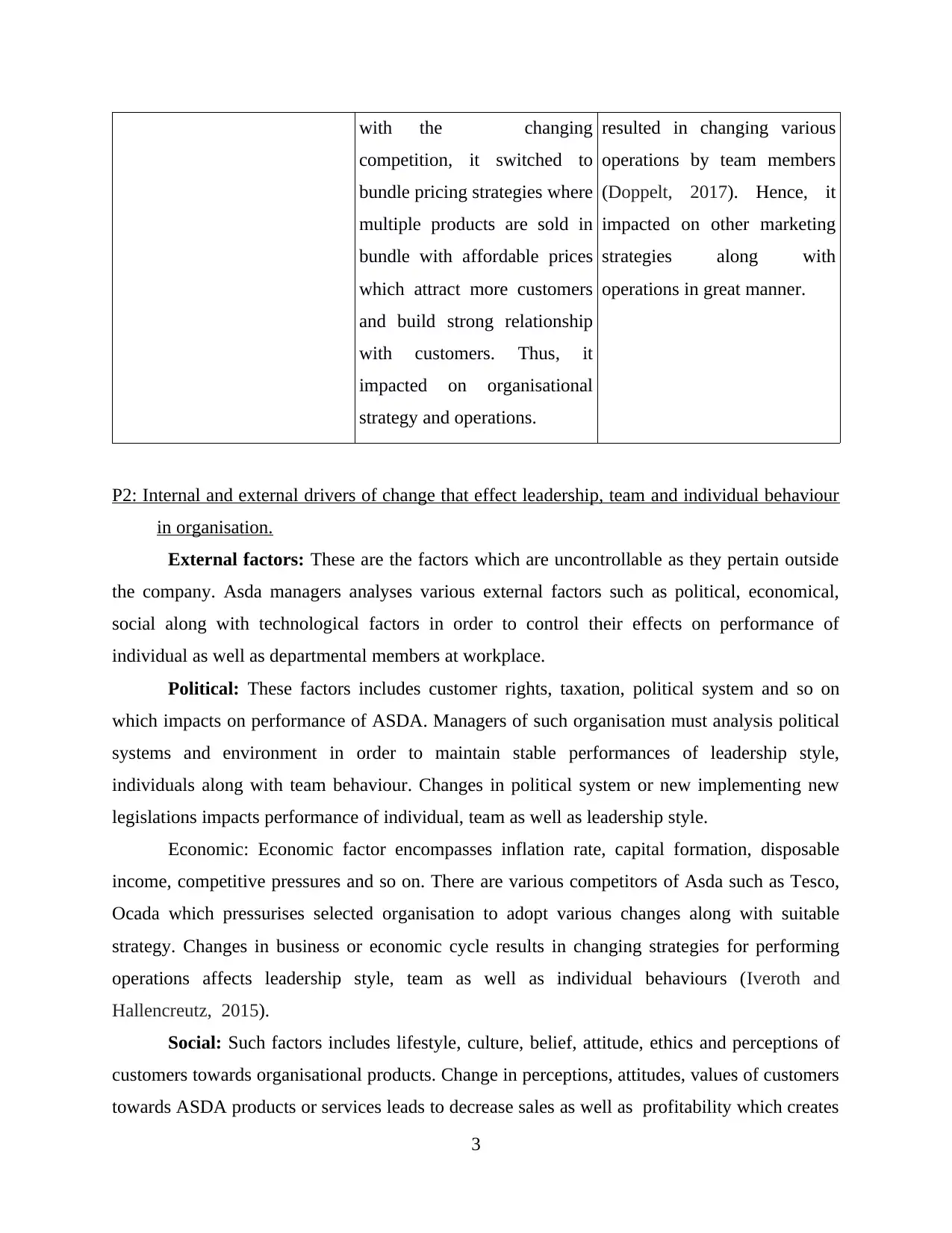
with the changing
competition, it switched to
bundle pricing strategies where
multiple products are sold in
bundle with affordable prices
which attract more customers
and build strong relationship
with customers. Thus, it
impacted on organisational
strategy and operations.
resulted in changing various
operations by team members
(Doppelt, 2017). Hence, it
impacted on other marketing
strategies along with
operations in great manner.
P2: Internal and external drivers of change that effect leadership, team and individual behaviour
in organisation.
External factors: These are the factors which are uncontrollable as they pertain outside
the company. Asda managers analyses various external factors such as political, economical,
social along with technological factors in order to control their effects on performance of
individual as well as departmental members at workplace.
Political: These factors includes customer rights, taxation, political system and so on
which impacts on performance of ASDA. Managers of such organisation must analysis political
systems and environment in order to maintain stable performances of leadership style,
individuals along with team behaviour. Changes in political system or new implementing new
legislations impacts performance of individual, team as well as leadership style.
Economic: Economic factor encompasses inflation rate, capital formation, disposable
income, competitive pressures and so on. There are various competitors of Asda such as Tesco,
Ocada which pressurises selected organisation to adopt various changes along with suitable
strategy. Changes in business or economic cycle results in changing strategies for performing
operations affects leadership style, team as well as individual behaviours (Iveroth and
Hallencreutz, 2015).
Social: Such factors includes lifestyle, culture, belief, attitude, ethics and perceptions of
customers towards organisational products. Change in perceptions, attitudes, values of customers
towards ASDA products or services leads to decrease sales as well as profitability which creates
3
competition, it switched to
bundle pricing strategies where
multiple products are sold in
bundle with affordable prices
which attract more customers
and build strong relationship
with customers. Thus, it
impacted on organisational
strategy and operations.
resulted in changing various
operations by team members
(Doppelt, 2017). Hence, it
impacted on other marketing
strategies along with
operations in great manner.
P2: Internal and external drivers of change that effect leadership, team and individual behaviour
in organisation.
External factors: These are the factors which are uncontrollable as they pertain outside
the company. Asda managers analyses various external factors such as political, economical,
social along with technological factors in order to control their effects on performance of
individual as well as departmental members at workplace.
Political: These factors includes customer rights, taxation, political system and so on
which impacts on performance of ASDA. Managers of such organisation must analysis political
systems and environment in order to maintain stable performances of leadership style,
individuals along with team behaviour. Changes in political system or new implementing new
legislations impacts performance of individual, team as well as leadership style.
Economic: Economic factor encompasses inflation rate, capital formation, disposable
income, competitive pressures and so on. There are various competitors of Asda such as Tesco,
Ocada which pressurises selected organisation to adopt various changes along with suitable
strategy. Changes in business or economic cycle results in changing strategies for performing
operations affects leadership style, team as well as individual behaviours (Iveroth and
Hallencreutz, 2015).
Social: Such factors includes lifestyle, culture, belief, attitude, ethics and perceptions of
customers towards organisational products. Change in perceptions, attitudes, values of customers
towards ASDA products or services leads to decrease sales as well as profitability which creates
3
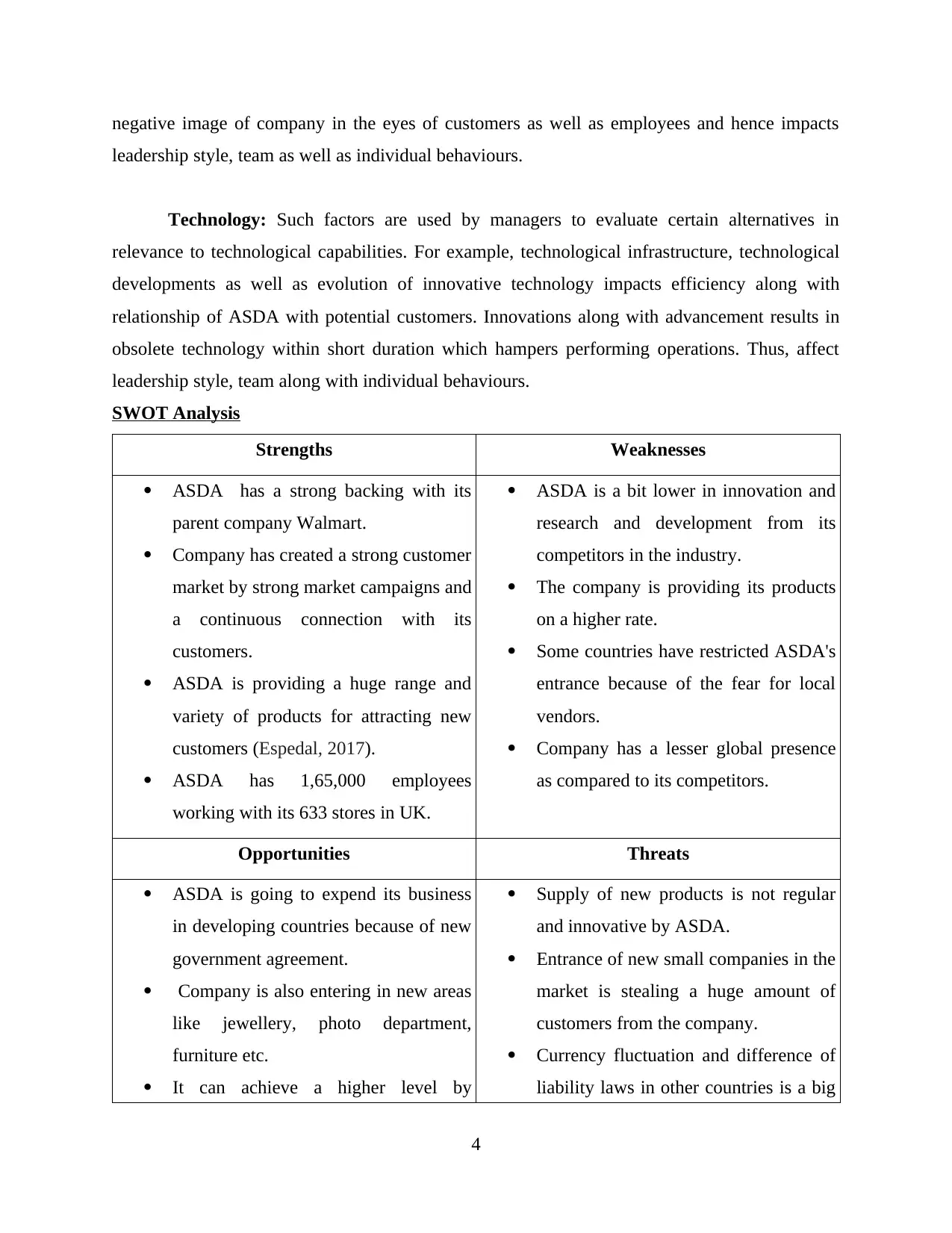
negative image of company in the eyes of customers as well as employees and hence impacts
leadership style, team as well as individual behaviours.
Technology: Such factors are used by managers to evaluate certain alternatives in
relevance to technological capabilities. For example, technological infrastructure, technological
developments as well as evolution of innovative technology impacts efficiency along with
relationship of ASDA with potential customers. Innovations along with advancement results in
obsolete technology within short duration which hampers performing operations. Thus, affect
leadership style, team along with individual behaviours.
SWOT Analysis
Strengths Weaknesses
ASDA has a strong backing with its
parent company Walmart.
Company has created a strong customer
market by strong market campaigns and
a continuous connection with its
customers.
ASDA is providing a huge range and
variety of products for attracting new
customers (Espedal, 2017).
ASDA has 1,65,000 employees
working with its 633 stores in UK.
ASDA is a bit lower in innovation and
research and development from its
competitors in the industry.
The company is providing its products
on a higher rate.
Some countries have restricted ASDA's
entrance because of the fear for local
vendors.
Company has a lesser global presence
as compared to its competitors.
Opportunities Threats
ASDA is going to expend its business
in developing countries because of new
government agreement.
Company is also entering in new areas
like jewellery, photo department,
furniture etc.
It can achieve a higher level by
Supply of new products is not regular
and innovative by ASDA.
Entrance of new small companies in the
market is stealing a huge amount of
customers from the company.
Currency fluctuation and difference of
liability laws in other countries is a big
4
leadership style, team as well as individual behaviours.
Technology: Such factors are used by managers to evaluate certain alternatives in
relevance to technological capabilities. For example, technological infrastructure, technological
developments as well as evolution of innovative technology impacts efficiency along with
relationship of ASDA with potential customers. Innovations along with advancement results in
obsolete technology within short duration which hampers performing operations. Thus, affect
leadership style, team along with individual behaviours.
SWOT Analysis
Strengths Weaknesses
ASDA has a strong backing with its
parent company Walmart.
Company has created a strong customer
market by strong market campaigns and
a continuous connection with its
customers.
ASDA is providing a huge range and
variety of products for attracting new
customers (Espedal, 2017).
ASDA has 1,65,000 employees
working with its 633 stores in UK.
ASDA is a bit lower in innovation and
research and development from its
competitors in the industry.
The company is providing its products
on a higher rate.
Some countries have restricted ASDA's
entrance because of the fear for local
vendors.
Company has a lesser global presence
as compared to its competitors.
Opportunities Threats
ASDA is going to expend its business
in developing countries because of new
government agreement.
Company is also entering in new areas
like jewellery, photo department,
furniture etc.
It can achieve a higher level by
Supply of new products is not regular
and innovative by ASDA.
Entrance of new small companies in the
market is stealing a huge amount of
customers from the company.
Currency fluctuation and difference of
liability laws in other countries is a big
4
⊘ This is a preview!⊘
Do you want full access?
Subscribe today to unlock all pages.

Trusted by 1+ million students worldwide
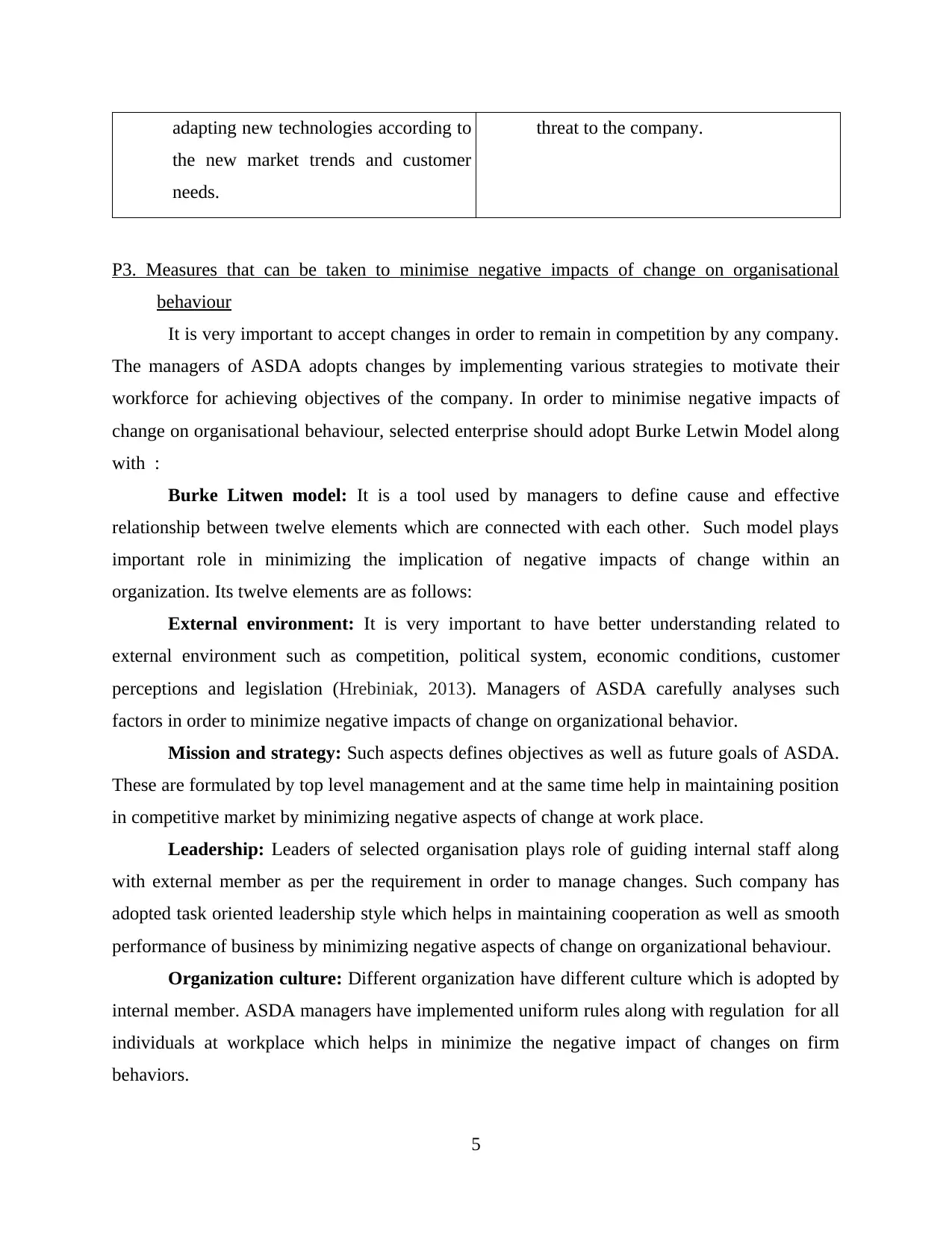
adapting new technologies according to
the new market trends and customer
needs.
threat to the company.
P3. Measures that can be taken to minimise negative impacts of change on organisational
behaviour
It is very important to accept changes in order to remain in competition by any company.
The managers of ASDA adopts changes by implementing various strategies to motivate their
workforce for achieving objectives of the company. In order to minimise negative impacts of
change on organisational behaviour, selected enterprise should adopt Burke Letwin Model along
with :
Burke Litwen model: It is a tool used by managers to define cause and effective
relationship between twelve elements which are connected with each other. Such model plays
important role in minimizing the implication of negative impacts of change within an
organization. Its twelve elements are as follows:
External environment: It is very important to have better understanding related to
external environment such as competition, political system, economic conditions, customer
perceptions and legislation (Hrebiniak, 2013). Managers of ASDA carefully analyses such
factors in order to minimize negative impacts of change on organizational behavior.
Mission and strategy: Such aspects defines objectives as well as future goals of ASDA.
These are formulated by top level management and at the same time help in maintaining position
in competitive market by minimizing negative aspects of change at work place.
Leadership: Leaders of selected organisation plays role of guiding internal staff along
with external member as per the requirement in order to manage changes. Such company has
adopted task oriented leadership style which helps in maintaining cooperation as well as smooth
performance of business by minimizing negative aspects of change on organizational behaviour.
Organization culture: Different organization have different culture which is adopted by
internal member. ASDA managers have implemented uniform rules along with regulation for all
individuals at workplace which helps in minimize the negative impact of changes on firm
behaviors.
5
the new market trends and customer
needs.
threat to the company.
P3. Measures that can be taken to minimise negative impacts of change on organisational
behaviour
It is very important to accept changes in order to remain in competition by any company.
The managers of ASDA adopts changes by implementing various strategies to motivate their
workforce for achieving objectives of the company. In order to minimise negative impacts of
change on organisational behaviour, selected enterprise should adopt Burke Letwin Model along
with :
Burke Litwen model: It is a tool used by managers to define cause and effective
relationship between twelve elements which are connected with each other. Such model plays
important role in minimizing the implication of negative impacts of change within an
organization. Its twelve elements are as follows:
External environment: It is very important to have better understanding related to
external environment such as competition, political system, economic conditions, customer
perceptions and legislation (Hrebiniak, 2013). Managers of ASDA carefully analyses such
factors in order to minimize negative impacts of change on organizational behavior.
Mission and strategy: Such aspects defines objectives as well as future goals of ASDA.
These are formulated by top level management and at the same time help in maintaining position
in competitive market by minimizing negative aspects of change at work place.
Leadership: Leaders of selected organisation plays role of guiding internal staff along
with external member as per the requirement in order to manage changes. Such company has
adopted task oriented leadership style which helps in maintaining cooperation as well as smooth
performance of business by minimizing negative aspects of change on organizational behaviour.
Organization culture: Different organization have different culture which is adopted by
internal member. ASDA managers have implemented uniform rules along with regulation for all
individuals at workplace which helps in minimize the negative impact of changes on firm
behaviors.
5
Paraphrase This Document
Need a fresh take? Get an instant paraphrase of this document with our AI Paraphraser
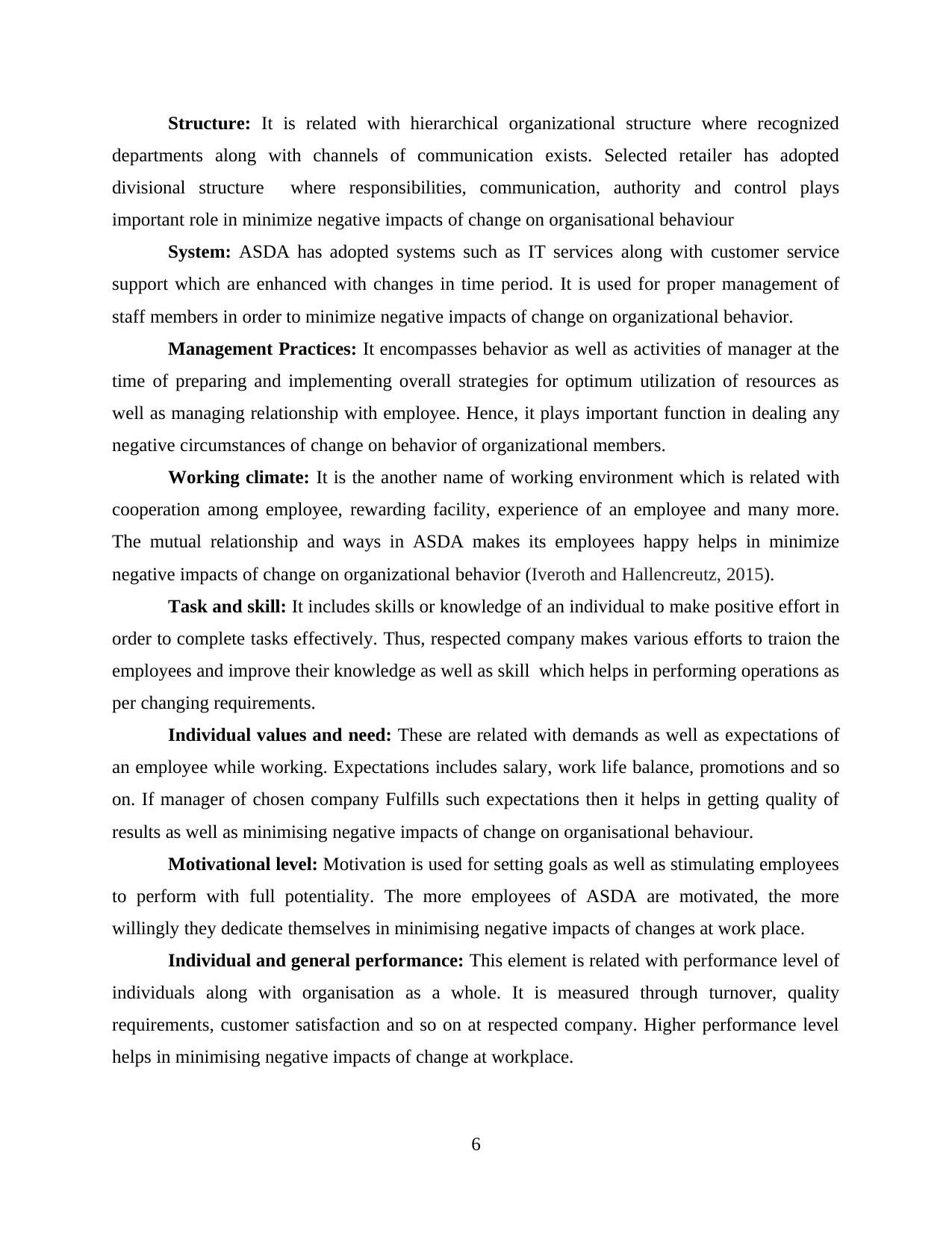
Structure: It is related with hierarchical organizational structure where recognized
departments along with channels of communication exists. Selected retailer has adopted
divisional structure where responsibilities, communication, authority and control plays
important role in minimize negative impacts of change on organisational behaviour
System: ASDA has adopted systems such as IT services along with customer service
support which are enhanced with changes in time period. It is used for proper management of
staff members in order to minimize negative impacts of change on organizational behavior.
Management Practices: It encompasses behavior as well as activities of manager at the
time of preparing and implementing overall strategies for optimum utilization of resources as
well as managing relationship with employee. Hence, it plays important function in dealing any
negative circumstances of change on behavior of organizational members.
Working climate: It is the another name of working environment which is related with
cooperation among employee, rewarding facility, experience of an employee and many more.
The mutual relationship and ways in ASDA makes its employees happy helps in minimize
negative impacts of change on organizational behavior (Iveroth and Hallencreutz, 2015).
Task and skill: It includes skills or knowledge of an individual to make positive effort in
order to complete tasks effectively. Thus, respected company makes various efforts to traion the
employees and improve their knowledge as well as skill which helps in performing operations as
per changing requirements.
Individual values and need: These are related with demands as well as expectations of
an employee while working. Expectations includes salary, work life balance, promotions and so
on. If manager of chosen company Fulfills such expectations then it helps in getting quality of
results as well as minimising negative impacts of change on organisational behaviour.
Motivational level: Motivation is used for setting goals as well as stimulating employees
to perform with full potentiality. The more employees of ASDA are motivated, the more
willingly they dedicate themselves in minimising negative impacts of changes at work place.
Individual and general performance: This element is related with performance level of
individuals along with organisation as a whole. It is measured through turnover, quality
requirements, customer satisfaction and so on at respected company. Higher performance level
helps in minimising negative impacts of change at workplace.
6
departments along with channels of communication exists. Selected retailer has adopted
divisional structure where responsibilities, communication, authority and control plays
important role in minimize negative impacts of change on organisational behaviour
System: ASDA has adopted systems such as IT services along with customer service
support which are enhanced with changes in time period. It is used for proper management of
staff members in order to minimize negative impacts of change on organizational behavior.
Management Practices: It encompasses behavior as well as activities of manager at the
time of preparing and implementing overall strategies for optimum utilization of resources as
well as managing relationship with employee. Hence, it plays important function in dealing any
negative circumstances of change on behavior of organizational members.
Working climate: It is the another name of working environment which is related with
cooperation among employee, rewarding facility, experience of an employee and many more.
The mutual relationship and ways in ASDA makes its employees happy helps in minimize
negative impacts of change on organizational behavior (Iveroth and Hallencreutz, 2015).
Task and skill: It includes skills or knowledge of an individual to make positive effort in
order to complete tasks effectively. Thus, respected company makes various efforts to traion the
employees and improve their knowledge as well as skill which helps in performing operations as
per changing requirements.
Individual values and need: These are related with demands as well as expectations of
an employee while working. Expectations includes salary, work life balance, promotions and so
on. If manager of chosen company Fulfills such expectations then it helps in getting quality of
results as well as minimising negative impacts of change on organisational behaviour.
Motivational level: Motivation is used for setting goals as well as stimulating employees
to perform with full potentiality. The more employees of ASDA are motivated, the more
willingly they dedicate themselves in minimising negative impacts of changes at work place.
Individual and general performance: This element is related with performance level of
individuals along with organisation as a whole. It is measured through turnover, quality
requirements, customer satisfaction and so on at respected company. Higher performance level
helps in minimising negative impacts of change at workplace.
6
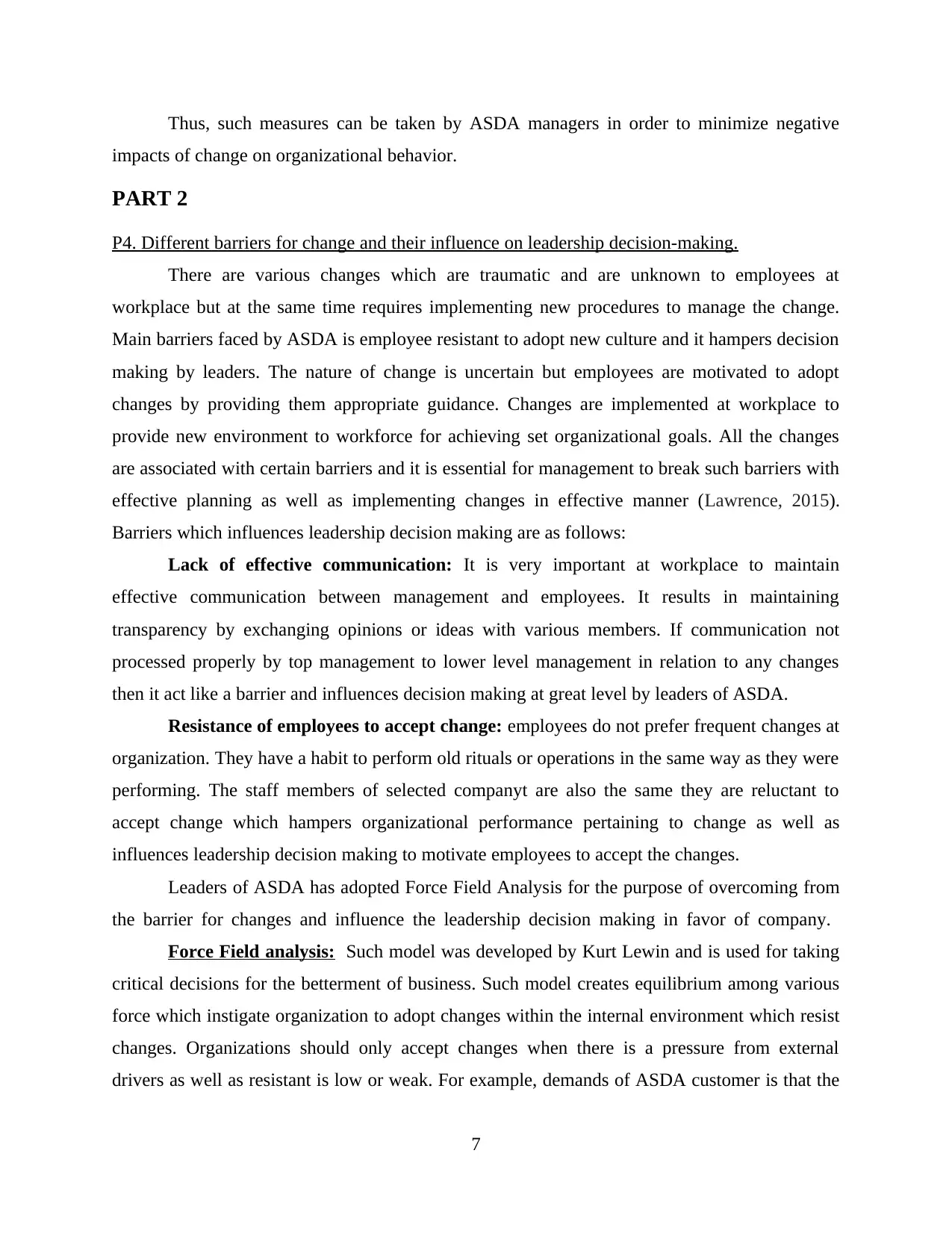
Thus, such measures can be taken by ASDA managers in order to minimize negative
impacts of change on organizational behavior.
PART 2
P4. Different barriers for change and their influence on leadership decision-making.
There are various changes which are traumatic and are unknown to employees at
workplace but at the same time requires implementing new procedures to manage the change.
Main barriers faced by ASDA is employee resistant to adopt new culture and it hampers decision
making by leaders. The nature of change is uncertain but employees are motivated to adopt
changes by providing them appropriate guidance. Changes are implemented at workplace to
provide new environment to workforce for achieving set organizational goals. All the changes
are associated with certain barriers and it is essential for management to break such barriers with
effective planning as well as implementing changes in effective manner (Lawrence, 2015).
Barriers which influences leadership decision making are as follows:
Lack of effective communication: It is very important at workplace to maintain
effective communication between management and employees. It results in maintaining
transparency by exchanging opinions or ideas with various members. If communication not
processed properly by top management to lower level management in relation to any changes
then it act like a barrier and influences decision making at great level by leaders of ASDA.
Resistance of employees to accept change: employees do not prefer frequent changes at
organization. They have a habit to perform old rituals or operations in the same way as they were
performing. The staff members of selected companyt are also the same they are reluctant to
accept change which hampers organizational performance pertaining to change as well as
influences leadership decision making to motivate employees to accept the changes.
Leaders of ASDA has adopted Force Field Analysis for the purpose of overcoming from
the barrier for changes and influence the leadership decision making in favor of company.
Force Field analysis: Such model was developed by Kurt Lewin and is used for taking
critical decisions for the betterment of business. Such model creates equilibrium among various
force which instigate organization to adopt changes within the internal environment which resist
changes. Organizations should only accept changes when there is a pressure from external
drivers as well as resistant is low or weak. For example, demands of ASDA customer is that the
7
impacts of change on organizational behavior.
PART 2
P4. Different barriers for change and their influence on leadership decision-making.
There are various changes which are traumatic and are unknown to employees at
workplace but at the same time requires implementing new procedures to manage the change.
Main barriers faced by ASDA is employee resistant to adopt new culture and it hampers decision
making by leaders. The nature of change is uncertain but employees are motivated to adopt
changes by providing them appropriate guidance. Changes are implemented at workplace to
provide new environment to workforce for achieving set organizational goals. All the changes
are associated with certain barriers and it is essential for management to break such barriers with
effective planning as well as implementing changes in effective manner (Lawrence, 2015).
Barriers which influences leadership decision making are as follows:
Lack of effective communication: It is very important at workplace to maintain
effective communication between management and employees. It results in maintaining
transparency by exchanging opinions or ideas with various members. If communication not
processed properly by top management to lower level management in relation to any changes
then it act like a barrier and influences decision making at great level by leaders of ASDA.
Resistance of employees to accept change: employees do not prefer frequent changes at
organization. They have a habit to perform old rituals or operations in the same way as they were
performing. The staff members of selected companyt are also the same they are reluctant to
accept change which hampers organizational performance pertaining to change as well as
influences leadership decision making to motivate employees to accept the changes.
Leaders of ASDA has adopted Force Field Analysis for the purpose of overcoming from
the barrier for changes and influence the leadership decision making in favor of company.
Force Field analysis: Such model was developed by Kurt Lewin and is used for taking
critical decisions for the betterment of business. Such model creates equilibrium among various
force which instigate organization to adopt changes within the internal environment which resist
changes. Organizations should only accept changes when there is a pressure from external
drivers as well as resistant is low or weak. For example, demands of ASDA customer is that the
7
⊘ This is a preview!⊘
Do you want full access?
Subscribe today to unlock all pages.

Trusted by 1+ million students worldwide
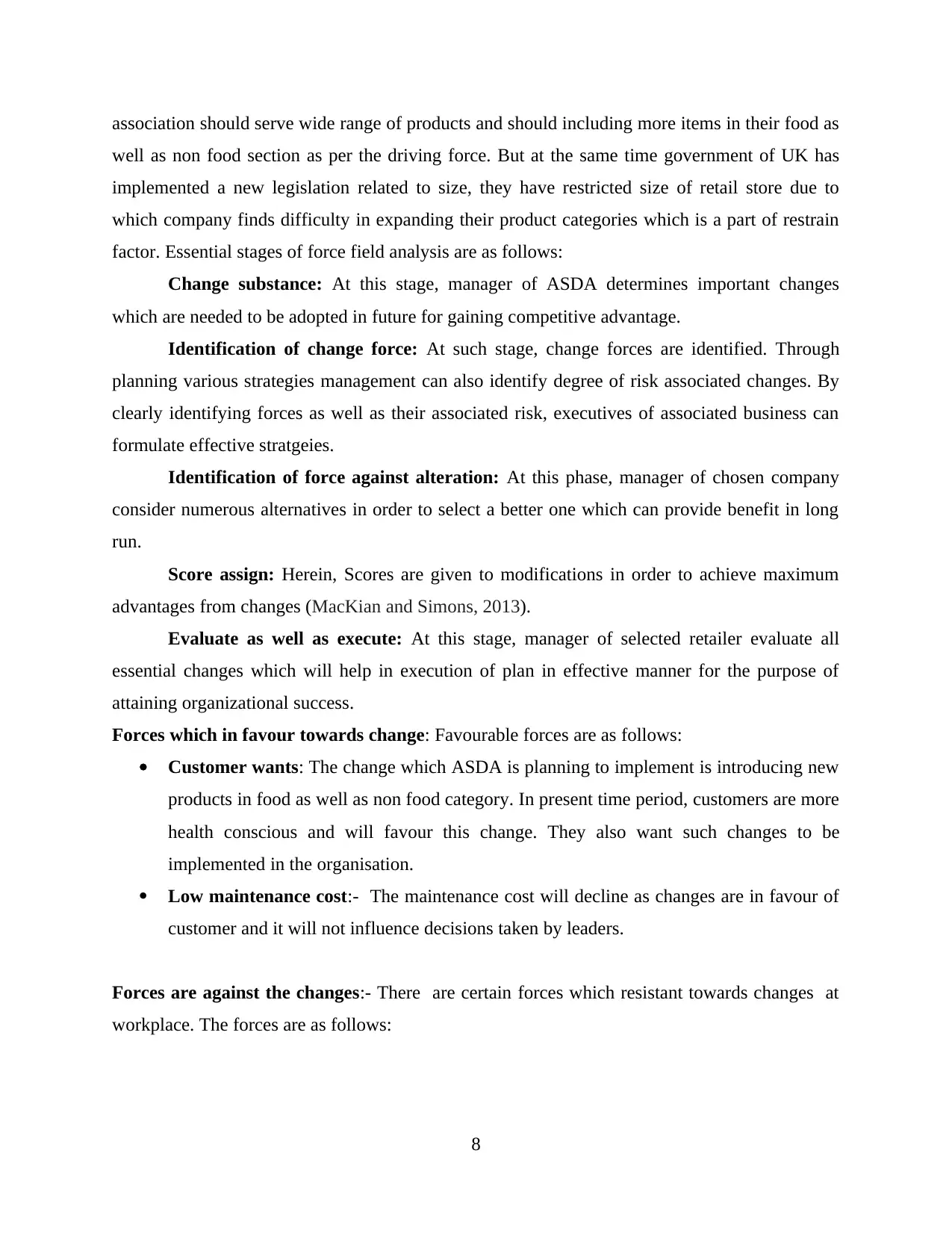
association should serve wide range of products and should including more items in their food as
well as non food section as per the driving force. But at the same time government of UK has
implemented a new legislation related to size, they have restricted size of retail store due to
which company finds difficulty in expanding their product categories which is a part of restrain
factor. Essential stages of force field analysis are as follows:
Change substance: At this stage, manager of ASDA determines important changes
which are needed to be adopted in future for gaining competitive advantage.
Identification of change force: At such stage, change forces are identified. Through
planning various strategies management can also identify degree of risk associated changes. By
clearly identifying forces as well as their associated risk, executives of associated business can
formulate effective stratgeies.
Identification of force against alteration: At this phase, manager of chosen company
consider numerous alternatives in order to select a better one which can provide benefit in long
run.
Score assign: Herein, Scores are given to modifications in order to achieve maximum
advantages from changes (MacKian and Simons, 2013).
Evaluate as well as execute: At this stage, manager of selected retailer evaluate all
essential changes which will help in execution of plan in effective manner for the purpose of
attaining organizational success.
Forces which in favour towards change: Favourable forces are as follows:
Customer wants: The change which ASDA is planning to implement is introducing new
products in food as well as non food category. In present time period, customers are more
health conscious and will favour this change. They also want such changes to be
implemented in the organisation.
Low maintenance cost:- The maintenance cost will decline as changes are in favour of
customer and it will not influence decisions taken by leaders.
Forces are against the changes:- There are certain forces which resistant towards changes at
workplace. The forces are as follows:
8
well as non food section as per the driving force. But at the same time government of UK has
implemented a new legislation related to size, they have restricted size of retail store due to
which company finds difficulty in expanding their product categories which is a part of restrain
factor. Essential stages of force field analysis are as follows:
Change substance: At this stage, manager of ASDA determines important changes
which are needed to be adopted in future for gaining competitive advantage.
Identification of change force: At such stage, change forces are identified. Through
planning various strategies management can also identify degree of risk associated changes. By
clearly identifying forces as well as their associated risk, executives of associated business can
formulate effective stratgeies.
Identification of force against alteration: At this phase, manager of chosen company
consider numerous alternatives in order to select a better one which can provide benefit in long
run.
Score assign: Herein, Scores are given to modifications in order to achieve maximum
advantages from changes (MacKian and Simons, 2013).
Evaluate as well as execute: At this stage, manager of selected retailer evaluate all
essential changes which will help in execution of plan in effective manner for the purpose of
attaining organizational success.
Forces which in favour towards change: Favourable forces are as follows:
Customer wants: The change which ASDA is planning to implement is introducing new
products in food as well as non food category. In present time period, customers are more
health conscious and will favour this change. They also want such changes to be
implemented in the organisation.
Low maintenance cost:- The maintenance cost will decline as changes are in favour of
customer and it will not influence decisions taken by leaders.
Forces are against the changes:- There are certain forces which resistant towards changes at
workplace. The forces are as follows:
8
Paraphrase This Document
Need a fresh take? Get an instant paraphrase of this document with our AI Paraphraser
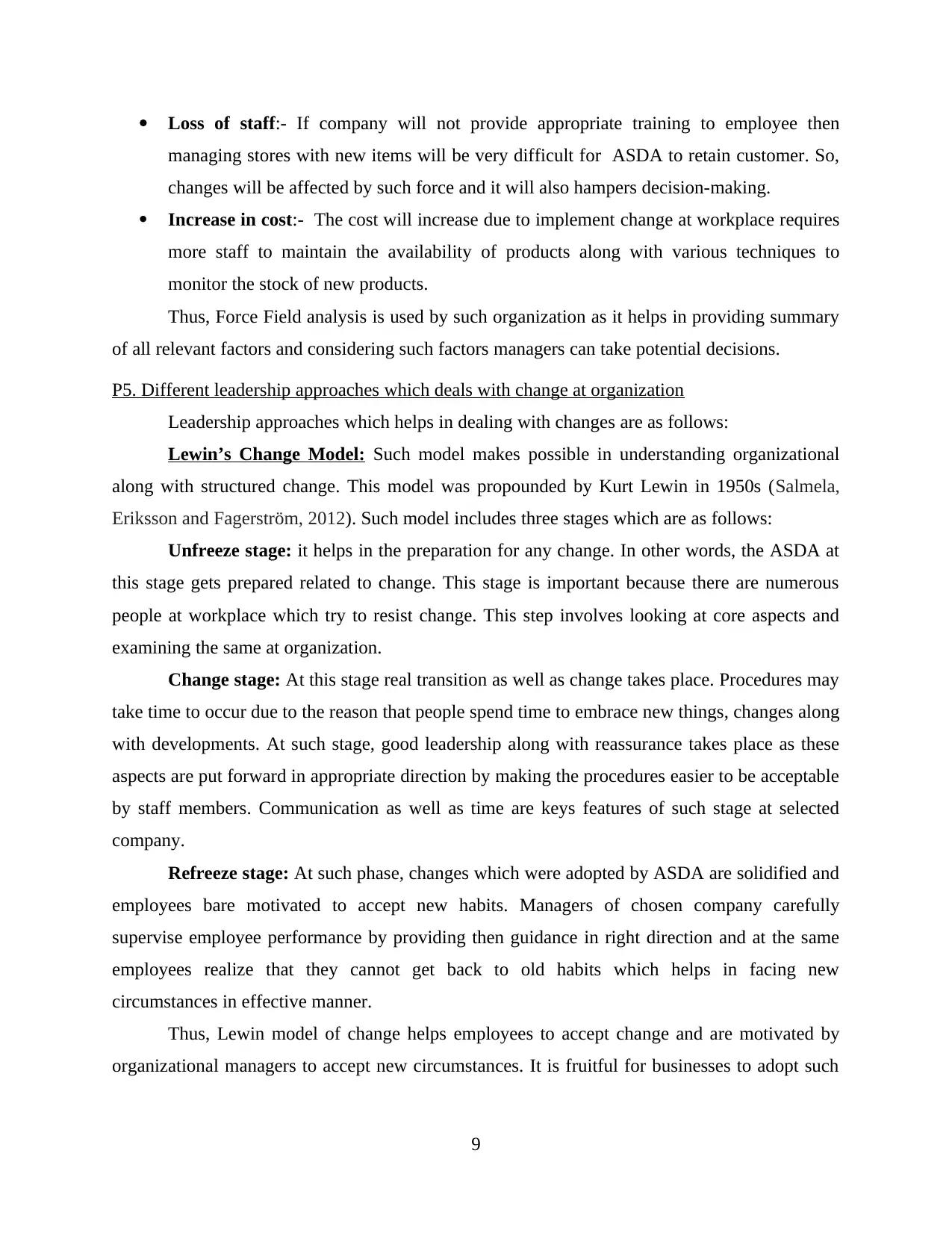
Loss of staff:- If company will not provide appropriate training to employee then
managing stores with new items will be very difficult for ASDA to retain customer. So,
changes will be affected by such force and it will also hampers decision-making.
Increase in cost:- The cost will increase due to implement change at workplace requires
more staff to maintain the availability of products along with various techniques to
monitor the stock of new products.
Thus, Force Field analysis is used by such organization as it helps in providing summary
of all relevant factors and considering such factors managers can take potential decisions.
P5. Different leadership approaches which deals with change at organization
Leadership approaches which helps in dealing with changes are as follows:
Lewin’s Change Model: Such model makes possible in understanding organizational
along with structured change. This model was propounded by Kurt Lewin in 1950s (Salmela,
Eriksson and Fagerström, 2012). Such model includes three stages which are as follows:
Unfreeze stage: it helps in the preparation for any change. In other words, the ASDA at
this stage gets prepared related to change. This stage is important because there are numerous
people at workplace which try to resist change. This step involves looking at core aspects and
examining the same at organization.
Change stage: At this stage real transition as well as change takes place. Procedures may
take time to occur due to the reason that people spend time to embrace new things, changes along
with developments. At such stage, good leadership along with reassurance takes place as these
aspects are put forward in appropriate direction by making the procedures easier to be acceptable
by staff members. Communication as well as time are keys features of such stage at selected
company.
Refreeze stage: At such phase, changes which were adopted by ASDA are solidified and
employees bare motivated to accept new habits. Managers of chosen company carefully
supervise employee performance by providing then guidance in right direction and at the same
employees realize that they cannot get back to old habits which helps in facing new
circumstances in effective manner.
Thus, Lewin model of change helps employees to accept change and are motivated by
organizational managers to accept new circumstances. It is fruitful for businesses to adopt such
9
managing stores with new items will be very difficult for ASDA to retain customer. So,
changes will be affected by such force and it will also hampers decision-making.
Increase in cost:- The cost will increase due to implement change at workplace requires
more staff to maintain the availability of products along with various techniques to
monitor the stock of new products.
Thus, Force Field analysis is used by such organization as it helps in providing summary
of all relevant factors and considering such factors managers can take potential decisions.
P5. Different leadership approaches which deals with change at organization
Leadership approaches which helps in dealing with changes are as follows:
Lewin’s Change Model: Such model makes possible in understanding organizational
along with structured change. This model was propounded by Kurt Lewin in 1950s (Salmela,
Eriksson and Fagerström, 2012). Such model includes three stages which are as follows:
Unfreeze stage: it helps in the preparation for any change. In other words, the ASDA at
this stage gets prepared related to change. This stage is important because there are numerous
people at workplace which try to resist change. This step involves looking at core aspects and
examining the same at organization.
Change stage: At this stage real transition as well as change takes place. Procedures may
take time to occur due to the reason that people spend time to embrace new things, changes along
with developments. At such stage, good leadership along with reassurance takes place as these
aspects are put forward in appropriate direction by making the procedures easier to be acceptable
by staff members. Communication as well as time are keys features of such stage at selected
company.
Refreeze stage: At such phase, changes which were adopted by ASDA are solidified and
employees bare motivated to accept new habits. Managers of chosen company carefully
supervise employee performance by providing then guidance in right direction and at the same
employees realize that they cannot get back to old habits which helps in facing new
circumstances in effective manner.
Thus, Lewin model of change helps employees to accept change and are motivated by
organizational managers to accept new circumstances. It is fruitful for businesses to adopt such
9
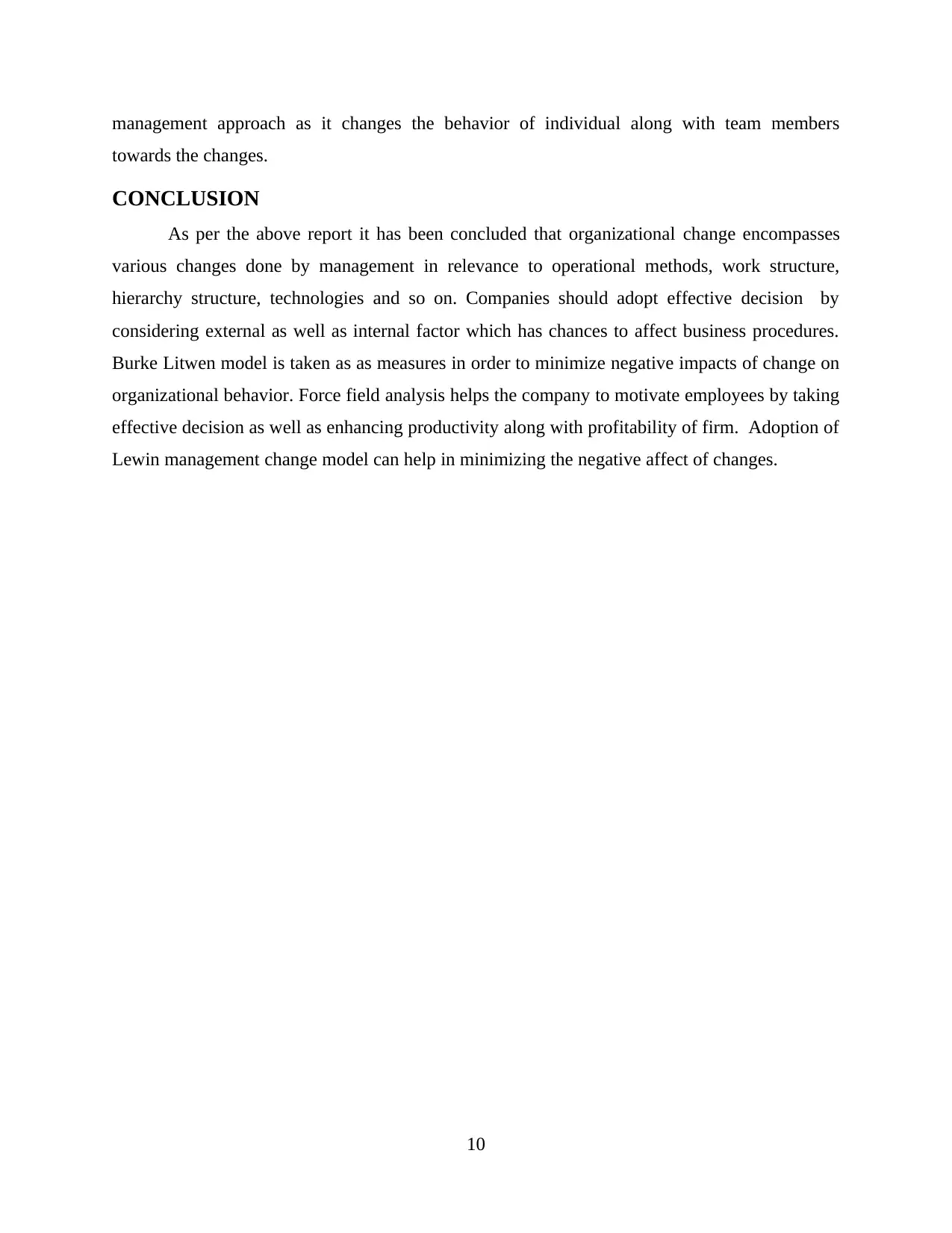
management approach as it changes the behavior of individual along with team members
towards the changes.
CONCLUSION
As per the above report it has been concluded that organizational change encompasses
various changes done by management in relevance to operational methods, work structure,
hierarchy structure, technologies and so on. Companies should adopt effective decision by
considering external as well as internal factor which has chances to affect business procedures.
Burke Litwen model is taken as as measures in order to minimize negative impacts of change on
organizational behavior. Force field analysis helps the company to motivate employees by taking
effective decision as well as enhancing productivity along with profitability of firm. Adoption of
Lewin management change model can help in minimizing the negative affect of changes.
10
towards the changes.
CONCLUSION
As per the above report it has been concluded that organizational change encompasses
various changes done by management in relevance to operational methods, work structure,
hierarchy structure, technologies and so on. Companies should adopt effective decision by
considering external as well as internal factor which has chances to affect business procedures.
Burke Litwen model is taken as as measures in order to minimize negative impacts of change on
organizational behavior. Force field analysis helps the company to motivate employees by taking
effective decision as well as enhancing productivity along with profitability of firm. Adoption of
Lewin management change model can help in minimizing the negative affect of changes.
10
⊘ This is a preview!⊘
Do you want full access?
Subscribe today to unlock all pages.

Trusted by 1+ million students worldwide
1 out of 13
Related Documents
Your All-in-One AI-Powered Toolkit for Academic Success.
+13062052269
info@desklib.com
Available 24*7 on WhatsApp / Email
![[object Object]](/_next/static/media/star-bottom.7253800d.svg)
Unlock your academic potential
Copyright © 2020–2025 A2Z Services. All Rights Reserved. Developed and managed by ZUCOL.





